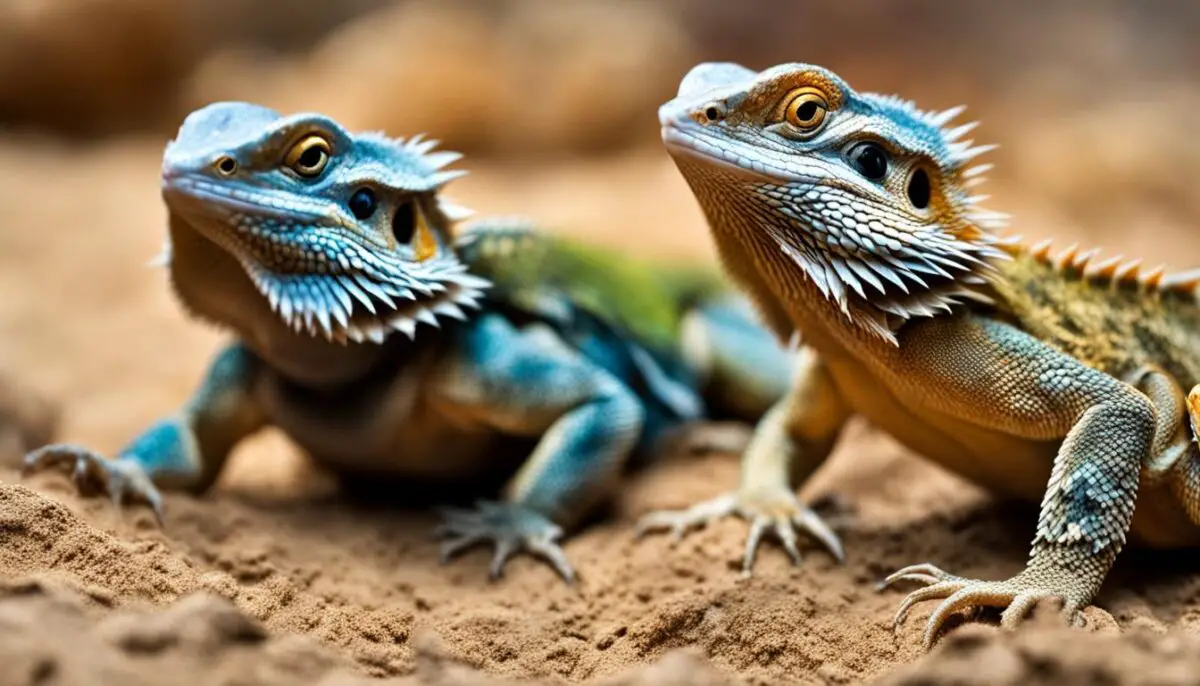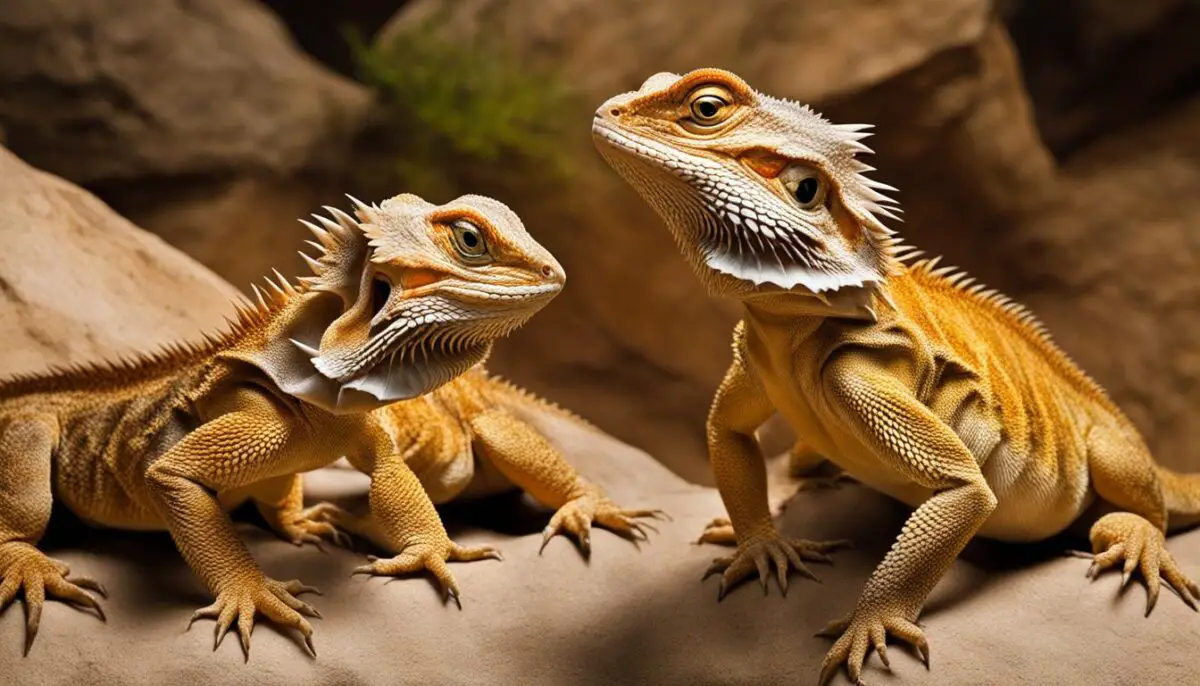Bearded dragons are fascinating reptiles known for their stunning appearance and unique behaviors. However, it’s important for owners to recognize that they can also exhibit aggressive behavior, leading to fights and potential harm. Understanding the reasons behind bearded dragon aggression is crucial for creating a peaceful and safe environment for these incredible creatures.
Key Takeaways:
- Bearded dragon aggression can be exhibited through various gestures, such as arm waving, head bobbing, and tail curling.
- Properly interpreting these behaviors is essential for preventing aggressive encounters.
- Bearded dragons communicate primarily through body language, including head bobs and arm waving.
- Territorial behavior is a common cause of aggression in bearded dragons, especially when housed together.
- Preventing bearded dragon fights can be achieved by providing separate enclosures, proper socialization, and maintaining a balanced diet and habitat.
Understanding Bearded Dragon Communication and Body Language
Bearded dragons have their own unique way of communicating, and understanding their body language is essential for every owner. By observing their behavior and gestures, you can gain valuable insights into your pet’s mood, needs, and potential aggression. Here’s a closer look at some key aspects of bearded dragon behavior and body language:
Head Bobs: Establishing Dominance and Submission
Head bobs are a common behavior in bearded dragons and serve as a way for them to establish dominance or submission. When your dragon gives quick up-and-down head movements, it is asserting its dominance over its surroundings. On the other hand, a slow and gentle head bob indicates submission to a higher-ranking dragon or even their owner. It’s important to recognize these gestures to maintain a harmonious interaction environment.
Arm Waving: Greeting and Species Recognition
Arm waving is a fascinating behavior that bearded dragons use to communicate with each other and recognize their own species. When a dragon waves its front legs in a slow and deliberate manner, it is attempting to greet another bearded dragon or show recognition. This friendly gesture helps them establish a sense of familiarity and comfort in their surroundings.
Color Changes: Temperature Regulation and Emotional Indicators
Bearded dragons can change their color, which serves various purposes. One of the primary reasons for color changes is temperature regulation. When they bask under the heat source, their color tends to darken, allowing them to absorb more warmth. Conversely, a lighter coloration indicates a desire to cool down.
It’s important to keep in mind that color changes can also be an indication of their emotional state. For instance, a darker coloration combined with puffing out their beard may be a sign of stress or feeling threatened.
Other Gestures and Behaviors
Bearded dragons exhibit a range of other behaviors that contribute to their body language:
- Basking: When dragons stretch out and lay under their heat source, it signifies their need for warmth and relaxation.
- Mouth Gaping: Opening their mouth wide helps bearded dragons regulate their temperature and release excess heat.
- Tail Pointing Upwards: A raised tail often indicates curiosity and attentiveness towards their surroundings.
By paying attention to these gestures and behaviors, you can effectively communicate with your bearded dragon and create a thriving, stress-free environment for them to thrive in.
| Behavior | Meaning |
|---|---|
| Head Bobs | Dominance or submission |
| Arm Waving | Greeting and species recognition |
| Color Changes | Temperature regulation and emotional indicators |
| Other Gestures | Basking, mouth gaping, tail pointing upwards |

Understanding the intricacies of bearded dragon communication and body language is crucial for their well-being and your ability to respond to their needs effectively. By observing their behavior closely and providing a suitable environment, you can foster a strong bond with your reptilian companion.
Reasons for Bearded Dragon Aggression and Fights
Bearded dragons, known for their unique and captivating behaviors, are naturally territorial creatures. This territorial behavior can often lead to aggression and fights, especially when multiple dragons are housed together.
Even same-sex bearded dragons should never be cohabitated, as it is not uncommon for them to engage in vicious fights with the intention to kill. To avoid putting your pets at risk, it is essential to provide separate enclosures for each individual dragon.
Male Territorial Behavior: Head Bobbing
Male bearded dragons often exhibit territorial aggression through head bobbing. This behavior serves as a visual display to establish dominance and claim their territory. When two males encounter each other, head bobbing can escalate into aggression and physical confrontations.
In order to prevent fights, it is essential to separate male dragons and provide them with their own personal space. This not only ensures their safety but also promotes a peaceful environment for each individual.
Female Aggression during Breeding Season
Female bearded dragons may display aggressive behavior during their breeding season. This aggression is primarily directed towards potential mates or rivals. It is important to consider the hormonal changes that occur in female bearded dragons during this time and understand that their aggression is a natural part of their reproductive cycle.
Providing separate enclosures for females during breeding season is crucial to avoid fights and protect the well-being of all dragons involved.
| Reasons for Bearded Dragon Aggression and Fights: | Prevention and Resolution: |
|---|---|
| 1. Territorial behavior | 1. Separate enclosures for each dragon |
| 2. Male territorial aggression (head bobbing) | 2. Avoid housing males together |
| 3. Female aggression during breeding season | 3. Provide separate enclosures for females |
Understanding the reasons behind bearded dragon aggression is essential for their well-being. By acknowledging their territorial nature and providing appropriate living arrangements, fights can be prevented. It is crucial to prioritize the safety and happiness of your bearded dragons to ensure a harmonious environment for these mesmerizing reptiles.

Preventing Bearded Dragon Fights
Bearded dragon fights can be a distressing and dangerous occurrence that can be avoided with proper care and attention. By implementing the following strategies, you can create a harmonious environment for your bearded dragons and reduce the risk of aggression.
Housing in Separate Enclosures
One of the most effective ways to prevent bearded dragon fights is to house each dragon in separate enclosures. This ensures that they have their own territories and reduces the likelihood of territorial disputes. Providing adequate space and enrichment within each enclosure is essential for their overall well-being.
Creating a Comforting Habitat
Offering hiding spots and creating a comfortable habitat can help minimize aggression in bearded dragons. Each enclosure should have suitable hiding places, such as caves or logs, where the dragons can retreat to when they feel threatened or stressed. Adequate temperatures and a well-maintained habitat contribute to a sense of security and can help reduce tension between dragons.
Socializing and Handling
Proper socialization and handling can greatly impact the behavior of bearded dragons. It is important to handle them regularly from a young age to familiarize them with human interaction. However, excessive handling or rough treatment can lead to stress and potential fights. Always handle your dragons gently and respect their boundaries.
Optimizing Diet and Hygiene
A balanced diet is crucial for the health and well-being of bearded dragons. Providing them with a varied diet that includes a mix of protein, vegetables, and fruits ensures their nutritional needs are met, reducing potential aggression caused by hunger or poor health. Additionally, maintaining a clean and hygienic habitat helps prevent the spread of diseases and reduces stress levels in your dragons.
By following these tips, you can create a safe and peaceful environment for your bearded dragons, minimizing the risk of fights and promoting their overall well-being.
| Preventing Bearded Dragon Fights |
|---|
| Housing in Separate Enclosures |
| Creating a Comforting Habitat |
| Socializing and Handling |
| Optimizing Diet and Hygiene |
Source:
First source, Third source
Conclusion
Bearded dragon fights can be a cause of concern for owners and have potential risks for the dragons involved. Understanding their communication, body language, and territorial behavior is crucial for preventing fights and maintaining a peaceful environment in their habitat.
By providing separate enclosures for your bearded dragons, you can minimize the chances of aggression and territorial disputes. Creating appropriate hiding spots within their enclosures allows them to establish their personal space and reduce the likelihood of fights.
Proper nutrition and habitat maintenance are also important factors in preventing aggression in bearded dragons. A balanced diet and a clean and hygienic habitat can contribute to their overall well-being and promote a calm and non-aggressive demeanor.
Bearded dragons exhibit fascinating behaviors that are unique to their species. By respecting their natural instincts and providing them with a safe and harmonious habitat, you can ensure the happiness and health of these amazing reptiles.
FAQ
What are some behaviors that indicate aggression in bearded dragons?
Aggressive behaviors in bearded dragons may include head bobbing, arm waving, beard fluffing, tail curling, and more. These gestures are indicative of their mood, health, and social interactions.
How do bearded dragons communicate through body language?
Through body language, bearded dragons communicate with head bobs to establish dominance or submission, arm waving as a form of greeting, and species recognition. They also change color for temperature regulation and to signal stress or disease.
Why do bearded dragons engage in fights?
Bearded dragons are naturally territorial creatures, which can lead to aggression and fights, especially when they are housed together. Even same-sex dragons should never be cohabitated as they may fight with the intention to kill.
How can I prevent bearded dragon fights?
To prevent fights, it is essential to house each bearded dragon in separate enclosures and provide adequate space, hiding spots, and appropriate temperatures. Socializing them from a young age and avoiding excessive handling can also reduce stress and potential fights.
What steps can I take to create a harmonious environment for my bearded dragons?
You can greatly reduce the risk of aggression in your bearded dragons by providing separate enclosures, appropriate hiding spots, ensuring a balanced diet, and maintaining a clean and hygienic habitat. Understanding their communication and natural instincts is crucial for a peaceful environment.


